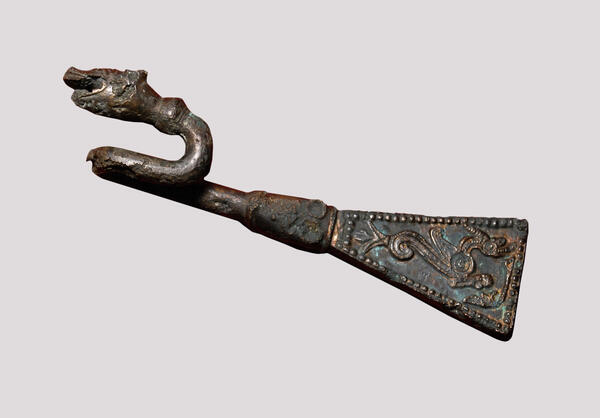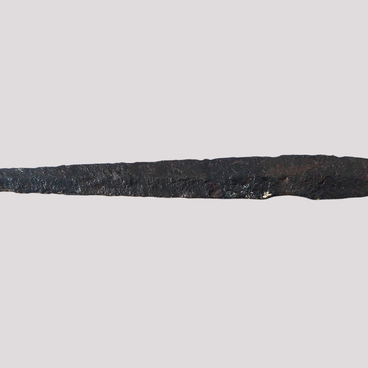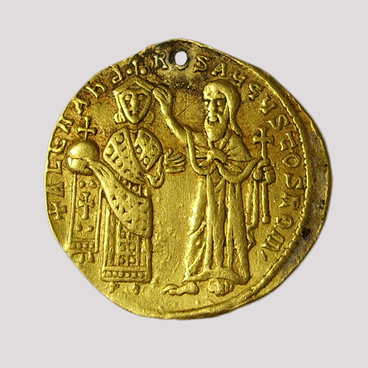About a third of all currently known Scandinavian items found in Eastern Europe originate from the Gnezdovo archaeological site.
An expedition of the Moscow State University and the State Historical Museum under the leadership of Avdusin in 1950 during the excavation of mound No. 47 of the Gnezdovo archaeological site found a bracket for hanging a sword with the image of a dragon. A sword bracket was found in the western part of the burial pyre.
The brace is a curved part designed to attach the sword sheath to the harness. The find dates to the 10th century. As known, from the beginning of the 10th century Smolensk was one of the cities through which the trade route ‘From the Varangians to the Greeks’ passed. Probably, it was in this way that Scandinavian objects came to the territory of Smolensk.
A dragon is depicted on a bracket from the Smolensk Museum. The dragon — a huge mythical serpent — was an important character in Scandinavian mythology. These mythological creatures played a significant role in the life of the Vikings. Images of dragons were used to decorate the rostrums, rune stones, bracelets and rings, dragon-snakes were the main ‘beasts’ in the ornaments of the Vikings, along with wolves and ravens.
Basically, dragons are huge snakes, often water ones, that can fly and kill with poison. But there are three main dragons that are remembered in mythology: Nidhogg, Jormungand and Fafnir.
The serpent Nidhogg has existed since the beginning of time and is usually busy gnawing at the roots of the World Tree — the Yggdrasil ash. This symbolizes the troubles and suffering of the world that are undermining the World Tree. Jormungand is the great serpent that encircles the whole world, symbolizing the beginning and end of everything, somewhat reminiscent of the European alchemical serpent devouring its own tail. Jormungand is mentioned more often in myths.
The dragon Fafnir does not live in the world of the gods, but in the world of people, in fact, it is a person who knows how to turn into a dragon. Fafnir acts in the Saga of the Völsungs — an epic work that in the future turned into the more famous Legend of the Nibelungs. Fafnir guarded the treasures that he inherited from the gods along with the cursed ring that brings misfortune to any owner.
An expedition of the Moscow State University and the State Historical Museum under the leadership of Avdusin in 1950 during the excavation of mound No. 47 of the Gnezdovo archaeological site found a bracket for hanging a sword with the image of a dragon. A sword bracket was found in the western part of the burial pyre.
The brace is a curved part designed to attach the sword sheath to the harness. The find dates to the 10th century. As known, from the beginning of the 10th century Smolensk was one of the cities through which the trade route ‘From the Varangians to the Greeks’ passed. Probably, it was in this way that Scandinavian objects came to the territory of Smolensk.
A dragon is depicted on a bracket from the Smolensk Museum. The dragon — a huge mythical serpent — was an important character in Scandinavian mythology. These mythological creatures played a significant role in the life of the Vikings. Images of dragons were used to decorate the rostrums, rune stones, bracelets and rings, dragon-snakes were the main ‘beasts’ in the ornaments of the Vikings, along with wolves and ravens.
Basically, dragons are huge snakes, often water ones, that can fly and kill with poison. But there are three main dragons that are remembered in mythology: Nidhogg, Jormungand and Fafnir.
The serpent Nidhogg has existed since the beginning of time and is usually busy gnawing at the roots of the World Tree — the Yggdrasil ash. This symbolizes the troubles and suffering of the world that are undermining the World Tree. Jormungand is the great serpent that encircles the whole world, symbolizing the beginning and end of everything, somewhat reminiscent of the European alchemical serpent devouring its own tail. Jormungand is mentioned more often in myths.
The dragon Fafnir does not live in the world of the gods, but in the world of people, in fact, it is a person who knows how to turn into a dragon. Fafnir acts in the Saga of the Völsungs — an epic work that in the future turned into the more famous Legend of the Nibelungs. Fafnir guarded the treasures that he inherited from the gods along with the cursed ring that brings misfortune to any owner.



